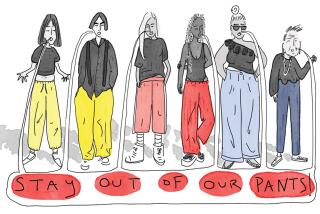I Sing the Body Aerodynamic
Oh, sure, it was lovely seeing Cathy Freeman’s winged run into fluttering hearts worldwide, her 400-meter flight to Olympic gold. A triumph of spirit, a symbol for the Aboriginal people. But when I watched her race this week in Sydney, hard as I tried to focus on what the Olympic Games are really about, my mind kept veering to the trite ponderings of the casual athlete that I am: What’s up with that hooded unitard?
It can’t be just a coincidence that all the losing runners wore traditional sports bras and short shorts, right? It can’t be just a coincidence that both Freeman and Marion Jones often run in chic Nike one-pieces. . . .
See, it is the province of slowpokes, thank you, to dream--not of smarter workouts but of smarter gear. Fabric that flies. Performance-enhancing outfits. Stuff you can buy.
Or try to buy, anyway. A Nike spokeswoman says the head-to-toe bodysuits worn by the Olympic athletes aren’t for sale. A design team spent more than two years creating the unitards, called the Swift Suit, for elite runners, who move so fast that they have problems the rest of us can only fantasize about. Aerodynamics, for instance. A sprinter’s body in motion creates a huge amount of drag. To reduce drag, the Nike team put a bunch of different fabrics in strategic places on the bodysuit; the effect is similar to the one that dimples have on a golf ball during its flight. The hood also cuts down on drag, with non-aerodynamic hair being tucked away.
So what about the rest of us who don’t have a Nike design team? How much of a boon can amateurs get from pricey “performance fabrics”? I mean, do my moisture-wicking aerobics tops really make me jump higher or run longer? Or do I just get a psychological edge from the enchanting idea of fabric that wicks away my sweat and keeps me dry as opposed to a plain old cotton T-shirt that soaks it up?
I used to throw on a T-shirt and shorts for any sporting occasion; the outfit was my little black dress of the outdoors. I gravitated toward natural fibers--cotton in summer, wool in winter--and turned up my nose at the idea of synthetics, the fabric equivalent of bioengineered food. But then the ads got to me.
I bought CoolMax, “the world’s first moisture management fabric,” after thinking during long runs, I really must manage my moisture. Then I started to hear about mesh. Mesh is light, porous and breathable. Now I wear only white, sun-reflecting mesh for three-mile summer runs in the cool of the morning, because, well, that’s what the ultra-marathoners wear in Death Valley and look how buff they are.
These days, in anticipation of a long trek I’m thinking about taking this spring, I’m on a bewildering search for what’s known as a storm shell, something to keep out the wind and rain.
The lexicon alone is wearing. I’m learning about Gore-Tex three-layer laminate versus the two-layer, which, I think, is something like the difference between one- and two-ply toilet paper. I know I must absolutely have a jacket that has pit zips so my armpits can take crucial, life-affirming breaths. And I’m fretting because new fabrics are coming on the market so fast that I’m afraid of buying a jacket that’ll be obsolete by spring. Cutting-edge fabrics that are silicon impregnated; I’m not sure what that does, but it sounds studly, and I probably need it.
Average athletes, some experts caution, should be careful about succumbing to sleek-gear ads that promise a performance edge. High-tech fabrics might make the difference only for world-class runners, whose progress is measured in milliseconds, says Richard Cotton, chief exercise physiologist for the San Diego-based American Council on Exercise.
“If it’s anything, it’s minuscule, and who needs it, unless you’re performing at that level,” he says.
In fact, he says, it would make better sense for casual runners to wear lightweight, short-sleeve shirts that cover more of the body, rather than the trendy, skimpy tops with cutouts in back that don’t offer much sun protection.
Also, you can’t slough off because you have cool running clothes, cautions trainer Dahelia Hunt, co-director of Professional Fitness Instructor Training in Houston. What counts is the work you put into the quest for fitness by eating right, resting and training.
“If you’re going to be really honest with yourself, ask, ‘Am I giving it all? Am I acting like an athlete? Or am I paying money out to make it look like I’m an athlete?’ ”
Not that looking like an athlete is a bad thing, says Pat Connelly, a Los Angeles Marathon training coach. He trains people who have never run a step, through the Marathon’s official training program, L.A. Roadrunners. Novices arrive at the track in cutoff Levis, black socks, football jerseys or the type of heavy cotton sweats they wore in high school gym classes. Others seem to have stepped off the pages of Runner’s World magazine.
Of course, Connelly first takes beginning runners through clothing basics, suggesting light, breathable tank tops and shorts as basic gear--but basic doesn’t mean frumpy.
“I think if you step out there and look like a runner, it makes you feel like a runner,” he says.
So maybe I wouldn’t morph into a Real Runner if I put on a Freeman-like aqua green catsuit. But I might feel a bit Freeman-esque.
And that would be something.
And I still want pit zips.
More to Read
Go beyond the scoreboard
Get the latest on L.A.'s teams in the daily Sports Report newsletter.
You may occasionally receive promotional content from the Los Angeles Times.






